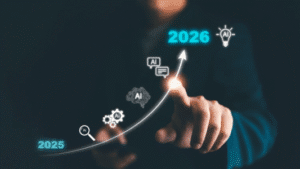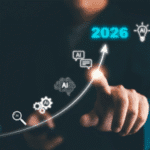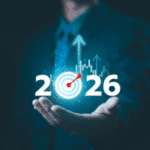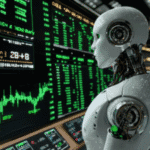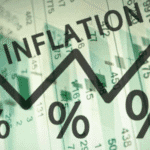
A New Financial Revolution
Artificial Intelligence (AI) is no longer just a buzzword — it’s the backbone of modern finance. From Wall Street to London, Singapore, and Dubai, algorithms powered by machine learning are now making millions of trading decisions every second.
In 2025, AI-driven trading is reshaping how investors analyze risk, predict trends, and execute trades. The rise of AI is not only changing how markets operate but also redefining what it means to be an investor.
This article explores how AI is revolutionizing financial trading, the technologies behind it, the risks and opportunities, and what this means for the future of global markets.
Section 1: What Is AI Trading and How Does It Work?
AI trading — also known as algorithmic trading or automated investing — uses advanced algorithms and data models to analyze massive amounts of financial data, identify patterns, and make buy or sell decisions without human intervention.
These systems can evaluate market sentiment, historical price movements, and even social media trends to predict market behavior.
Core Technologies Behind AI Trading
- Machine Learning (ML): Enables systems to learn from historical data and improve over time.
- Natural Language Processing (NLP): Analyzes news, reports, and tweets to gauge market sentiment.
- Neural Networks: Mimic human brain processes to recognize complex patterns in stock movements.
- High-Frequency Trading (HFT): Executes thousands of trades per second based on micro-fluctuations.
- Predictive Analytics: Forecasts future price trends based on multidimensional data inputs.
These tools allow AI traders to act with precision and speed that no human can match.
Section 2: How AI Is Changing the Role of Traders and Investors
Traditional traders relied on experience, instinct, and manual analysis. AI traders, on the other hand, rely on real-time data and mathematical precision.
Key Shifts in the Financial Industry
- Human traders → AI analysts: Machines handle complex trades; humans supervise strategy.
- Manual trading → Automated execution: Most hedge funds and institutions now rely on automated systems for large-volume trades.
- Data-driven investing → Emotion-free decisions: AI eliminates fear and greed — two emotions that often lead to bad investments.
Fact: More than 70% of all stock market trades in major exchanges like the NYSE and NASDAQ are now executed by algorithms.
Section 3: The Major Players in AI Trading
Several financial giants are leading the AI revolution in global markets:
- BlackRock – Aladdin Platform:
Manages trillions using AI to assess risk and optimize portfolios. - Goldman Sachs – Kensho:
Uses natural language processing to analyze global events and their impact on markets. - Citadel Securities:
One of the largest algorithmic trading firms, executing billions in trades daily. - JP Morgan – LOXM:
An AI trading engine that reduces transaction costs and improves execution speed. - Startups like Kavout and Numerai:
Democratize AI trading by allowing retail investors to benefit from institutional-grade algorithms.
Section 4: The Advantages of AI in Financial Trading
AI has revolutionized trading through several critical benefits:
- Speed and Efficiency
AI algorithms execute orders in milliseconds, capitalizing on fleeting opportunities. - Data Analysis at Scale
AI can process millions of data points — from stock prices to news headlines — instantly. - Reduced Human Bias
Machines make logical, emotion-free decisions, improving overall portfolio discipline. - Cost Reduction
Automated systems reduce operational costs for brokers and asset managers. - Improved Accuracy
Predictive analytics help forecast short-term price movements with remarkable precision.
Section 5: The Risks and Limitations of AI Trading
Despite its power, AI trading comes with significant challenges:
- Flash Crashes: Automated systems can cause sudden market collapses if algorithms misinterpret data.
- Overfitting: AI models trained on past data may fail under new, unpredictable conditions.
- Ethical Concerns: Unchecked automation may create unfair market advantages for large institutions.
- Dependence on Data Quality: Poor or manipulated data can lead to massive trading losses.
- Cybersecurity Threats: AI systems are vulnerable to hacking and algorithmic manipulation.
Section 6: AI and Market Regulation
Regulators are catching up. Agencies like the U.S. Securities and Exchange Commission (SEC), European Securities and Markets Authority (ESMA), and Monetary Authority of Singapore (MAS) are introducing new frameworks for AI-based trading.
Key priorities include:
- Ensuring transparency in algorithmic models
- Preventing market manipulation
- Requiring human oversight for all automated trading systems
Global cooperation will be essential to balance innovation with market stability.
Section 7: Retail Investors Enter the AI Era
AI trading is no longer exclusive to hedge funds. Retail investors now have access to AI-powered tools and platforms, such as:
- eToro CopyTrader – Uses AI to replicate successful trading strategies.
- Trade Ideas – AI-driven stock scanning and prediction.
- Trefis and Zacks – Leverage data analytics to forecast stock performance.
- Wealthfront and Betterment – AI-based robo-advisors for long-term investing.
These tools allow ordinary investors to compete with professionals by making data-driven decisions at minimal cost.
Section 8: The Future of AI in Global Markets
The future of AI in trading will be defined by:
- Quantum computing – exponentially faster processing power for predictive analytics.
- Explainable AI (XAI) – making algorithmic decisions more transparent.
- Cross-asset automation – AI that integrates stocks, crypto, forex, and commodities.
- Sustainable finance algorithms – AI that evaluates ESG (Environmental, Social, Governance) performance alongside financial metrics.
Within the next five years, AI systems will likely control over 85% of global financial transactions — transforming how markets function forever.
Section 9: How to Invest in the AI Trading Boom
If you want to profit from the rise of AI in finance, consider investing in:
- Public AI-driven companies: Nvidia, Alphabet, Microsoft, Palantir, and AMD.
- Fintech innovators: Firms like Upstart, Robinhood, and SoFi that use AI to manage risk and lending.
- ETFs and funds: Such as the Global X Artificial Intelligence & Technology ETF (AIQ) or ARK Autonomous Technology ETF (ARKQ).
Diversifying your portfolio with exposure to AI technology ensures you benefit from both the software and hardware driving the revolution.
Conclusion: A New Age of Intelligent Investing
The rise of AI marks a fundamental shift in how the world trades and invests. Markets are becoming more efficient, but also more unpredictable.
In this environment, success will depend not on intuition but on data, discipline, and technology.
AI isn’t replacing human investors — it’s empowering them to think bigger, act faster, and make smarter financial decisions.
As the global financial system embraces automation, one truth remains clear:
The future of trading belongs to those who understand and master artificial intelligence.








